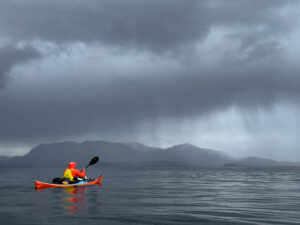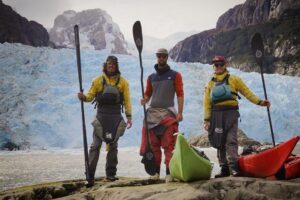“The inhabitants of the Aleutian Islands lived more or less in the same environment for maybe as long as 9,000 years. To me, [it’s not surprising] that they made some of the finest kayaks in the world.”
Anders Thygesen had never seen a traditional Aleutian kayak in real life before he built his first one. But that didn’t dissuade him. The Dane studied plans, looked at photographs and illustrations, and got to work. After he finished his first one, he paddled it around his local lake, then turned it into firewood and started over.

Anders Thygesen begins kayak construction. Photo: Screenshot
We join him hundreds of iterations later in the short film A Thousand Hands Ago. On the shores of a pond, Thygesen slowly crafts a kayak using a blend of modern tools and traditional methods.

Thygesen using his nose to find a center point between his outstretched arms. Photo: Screenshot
Most notably, the native Aleutians didn’t have measuring devices. So Thygesen uses the distance between the tip of his index finger and thumb as a standard unit. And he uses the tip of his nose to find the center point between his two outstretched hands.
A meditative journey
Every joint in the boat is fastened by cordage or a dowl — meaning every joint is flexible. Just like the Inuit used to build their kayaks (and dogsleds).
“There is strength in that flexibility,” Thygesen says, speaking a truth internalized long ago by cultures ranging from Aleutian boat builders to Greek gymnasts to Chinese Wing Chun practitioners.

Flexible joints add strength to the frame. Photo: Screenshot
There are no plans or blueprints besides the rudimentary sketch Thygesen draws in the wet sand in A Thousand Hands Ago‘s opening frames. Everything is slotted into place via dead reckoning and eyeballing. Thygesen is looking for curves that please him.
“The shape that is perfect to the eye is very often perfect at sea also,” he says.

Looking for curves. Photo: Screenshot
Once a canvas skin has been stretched over the frame and sealed, Thygesen’s newest kayak is ready for the water. And Thygesen isn’t looking for a stoke-filled experience.
“One of my favorite paddle experiences…I call it the world’s most boring paddle trip. I paddle in my local lake where the view doesn’t change at all. It has become a kind of meditation for me. After 20 minutes or half an hour, your thoughts stop.”

A paddling meditation. Photo: Screenshot
Is this boat headed for the fire as well? Thygesen doesn’t say, but one suspects that, like a sand mandala, each boat the Dane creates is destined to be a symbol of impermanence.
Luckily for us, filmmaker Silje Ensby captured a slice of Thygesen’s life — and one of his boats — with this gorgeously rendered short. Watch it below.






